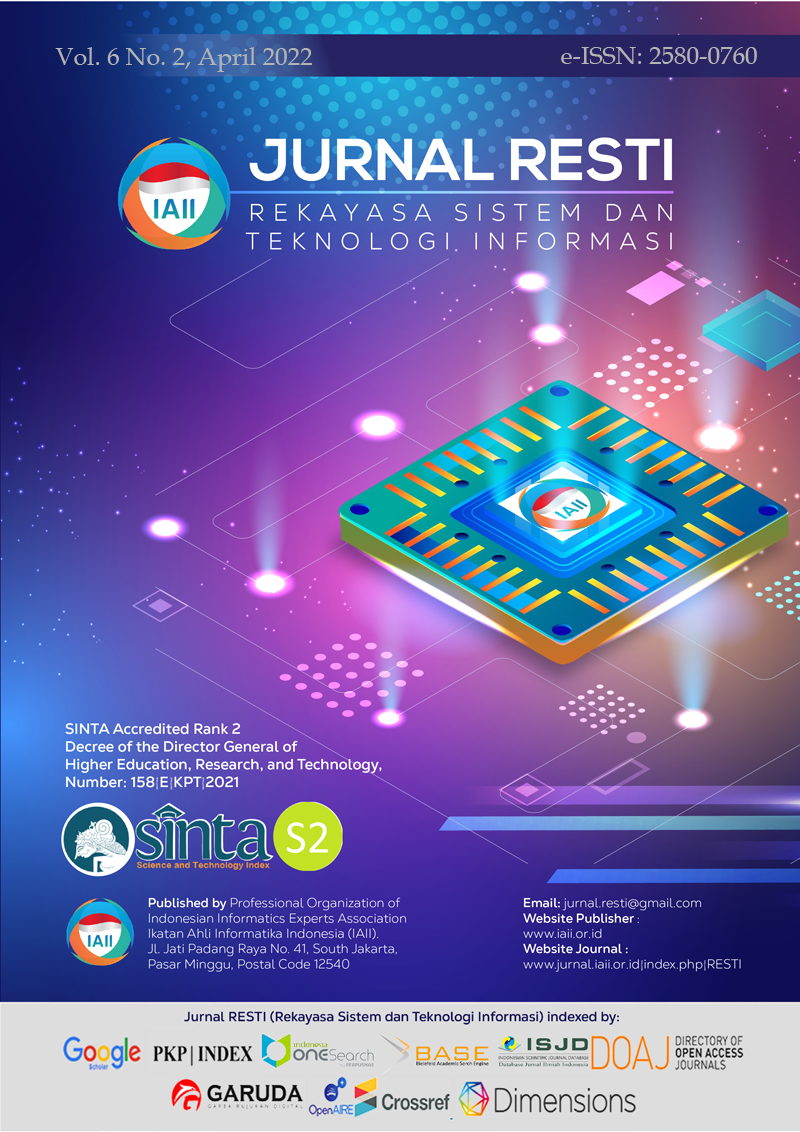Prediction of Water Levels on Peatland using Deep Learning
Abstract
The water level on peatlands is one of the causes of peatland fires, so water levels must be maintained at a safe standard value. Government Regulation No. 71/2014 stipulates water level standard value is 0.4 meters. The forest and land fires in 2015 caused huge losses of 220 trillion Rupiah. However, fires still occur frequently. BRGM (Peatland and Mangrove Restoration Agency) installed sensors measuring peatland water levels to obtain real-time data. These data can be used to predict water levels. Several previous studies used drought indices, regression models, and artificial neural networks to predict water levels. In this study, it is proposed to use deep learning Long Short-Term Memory (LSTM), and apply the CRISP-DM methodology. The dataset in this study contains water level data from 15 measurement stations in Central Kalimantan from 2018 through 2021. It was concluded that the LSTM model could predict water level well, as indicated by the average RMSE of 0.07 m, the average R2 of 0.85, and the average MAE of 0.04 m. The optimal LSTM model parameters are 50 epochs, a 70%:30% ratio of training data to testing data, and two hidden layers.
Downloads
References
N. Febrianti, K. Murtilaksono, and B. Barus, “Analisis Model Estimasi Tinggi Muka Air Tanah Menggunakan Indek Kekeringan,” J. Penginderaan Jauh dan Pengolah. Data Citra Digit., vol. 15, no. 1, pp. 25–36, 2018, doi: 10.30536/j.pjpdcd.2018.v15.a2867.
BNPB, “Rekapitulasi Luas Kebakaran Hutan dan Lahan (Ha) Per Provinsi Di Indonesia Tahun 2014-2019,” Karhutla Monitoring Sistem, 2019. http://sipongi.menlhk.go.id/hotspot/luas_kebakaran (accessed Aug. 01, 2021).
WorldBank, “Krisis Kebakaran dan Asap Indonesia,” Worldbank.Org, 2015. https://www.worldbank.org/en/news/feature/2015/12/01/indonesias-fire-and-haze-crisis (accessed Jul. 01, 2021).
M. Bernie, “BNPB Habiskan Rp6 , 7 Triliun untuk Tangani Bencana Selama 2019,” 2019. https://tirto.id/bnpb-habiskan-rp67-triliun-untuk-tangani-bencana-selama-2019-epRS (accessed Jul. 01, 2021).
PP-71, “Peraturan Pemerintah Republik Indonesia Nomor 71 Tahun 2014 Tentang Perlindungan Dan Pengelolaan Ekosistem Gambut,” p. 38, 2014.
S. Poornima and M. Pushpalatha, “Prediction of rainfall using intensified LSTM based recurrent Neural Network with Weighted Linear Units,” Atmosphere (Basel)., vol. 10, no. 11, 2019, doi: 10.3390/atmos10110668.
M. Rizki, S. Basuki, and Y. Azhar, “Implementasi Deep Learning Menggunakan Arsitektur Long Short Term Memory(LSTM) Untuk Prediksi Curah Hujan Kota Malang,” J. Repos., vol. 2, no. 3, p. 331, 2020, doi: 10.22219/repositor.v2i3.470.
C. J. Zhang, J. Zeng, H. Y. Wang, L. M. Ma, and H. Chu, “Correction model for rainfall forecasts using the LSTM with multiple meteorological factors,” Meteorol. Appl., vol. 27, no. 1, pp. 1–15, 2020, doi: 10.1002/met.1852.
C. Hu, Q. Wu, H. Li, S. Jian, N. Li, and Z. Lou, “Deep learning with a long short-term memory networks approach for rainfall-runoff simulation,” Water (Switzerland), vol. 10, no. 11, pp. 1–16, 2018, doi: 10.3390/w10111543.
J. Zhang, Y. Zhu, X. Zhang, M. Ye, and J. Yang, “Developing a Long Short-Term Memory (LSTM) based model for predicting water table depth in agricultural areas,” J. Hydrol., vol. 561, no. April, pp. 918–929, 2018, doi: 10.1016/j.jhydrol.2018.04.065.
N. E. Putra, S. Sutikno, and M. Fauzi, “Model Prediksi Kedalaman Muka Air Tanah pada Lahan Gambut Tropis,” Apl. Teknol., vol. 11, no. 2, 2019.
J. Qin, J. Liang, T. Chen, X. Lei, and A. Kang, “Simulating and predicting of hydrological time series based on tensorflow deep learning,” Polish J. Environ. Stud., vol. 28, no. 2, pp. 795–802, 2019, doi: 10.15244/pjoes/81557.
M. Sit, B. Z. Demiray, Z. Xiang, G. J. Ewing, Y. Sermet, and I. Demir, “A comprehensive review of deep learning applications in hydrology and water resources,” Water Sci. Technol., 2020, doi: 10.2166/wst.2020.369.
C. Pete et al., “Crisp-Dm 1.0, Step-by-step data mining guide,” Cris. Consort., p. 76, 2000.
C. Olah, “Understanding LSTM Networks [Blog],” Web Page, 2015. http://colah.github.io/posts/2015-08-Understanding-LSTMs/ (accessed Jul. 01, 2021).
Copyright (c) 2022 Jurnal RESTI (Rekayasa Sistem dan Teknologi Informasi)

This work is licensed under a Creative Commons Attribution 4.0 International License.
Copyright in each article belongs to the author
- The author acknowledges that the RESTI Journal (System Engineering and Information Technology) is the first publisher to publish with a license Creative Commons Attribution 4.0 International License.
- Authors can enter writing separately, arrange the non-exclusive distribution of manuscripts that have been published in this journal into other versions (eg sent to the author's institutional repository, publication in a book, etc.), by acknowledging that the manuscript has been published for the first time in the RESTI (Rekayasa Sistem dan Teknologi Informasi) journal ;








